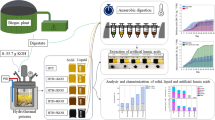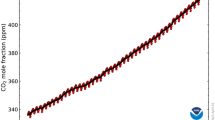Abstract
Alum water treatment sludge is composed of amorphous hydroxyl-Al, which has variable charge surfaces with a large Brunauer-Emmett-Teller (BET) surface area (103 m−2 g−1) capable of specific adsorption of organic matter molecules, phosphate, and heavy metals. The effects of adding dried, ground, alum water treatment sludge (10 % w/w) to the feedstock for composting municipal green waste alone, green waste plus poultry manure, or green waste plus biosolids were determined. Addition of water treatment sludge reduced water soluble C, microbial biomass C, CO2 evolution, extractable P, and extractable heavy metals during composting. The decrease in CO2 evolution (i.e., C sequestration) was greatest for poultry manure and least for biosolid composts. The effects of addition of water treatment sludge to mature green waste-based poultry manure and biosolid composts were also determined in a 24-week incubation experiment. The composts were either incubated alone or after addition to a soil. Extractable P and heavy metal concentrations were decreased by additions of water treatment sludge in all treatments, and CO2 evolution was also reduced from the poultry manure compost over the first 16–18 weeks. However, for biosolid compost, addition of water treatment sludge increased microbial biomass C and CO2 evolution rate over the entire 24-week incubation period. This was attributed to the greatly reduced extractable heavy metal concentrations (As, Cr, Cu, Pb, and Zn) present following addition of water treatment sludge, and thus increased microbial activity. It was concluded that addition of water treatment sludge reduces concentrations of extractable P and heavy metals in composts and that its effect on organic matter stabilization is much greater during the composting process than for mature compost because levels of easily decomposable organic matter are initially much higher in the feedstock than those in matured composts.




Similar content being viewed by others
References
Anderson JPE (1982) Soil respiration. In: Page AL (ed) Methods of soil analysis, part 2. Chemical and microbial properties. American Society of Agronomy, Madison, pp 837–871
Babatunde AO, Zhao YQ (2007) Constructive approaches toward water treatment works sludge management: an international review of beneficial reuses. Crit Rev Environ Sci Technol 37:128–164
Babatunde AO, Zhao YQ, Burke AM, Morris MA, Hanrahan JP (2009) Characterization of aluminium-based water treatment residual for potential phosphorus removal in engineered wetlands. Environ Pollut 157:2830–2836
Babatunde AO, Zhao YQ, Zhao XH (2010) Alum sludge-based constructed wetland system for enhanced removal of P and OM from wastewater: concept, design and performance analysis. Bioresour Technol 101:6576–6579
Belyaeva ON, Haynes RJ (2009) Chemical, microbial and physical properties of manufactured soils produced by co-composting municipal green waste with coal fly ash. Bioresour Technol 100:5203–5209
Belyaeva ON, Haynes RJ (2010) A comparison of the properties of manufactured soils produced from composting municipal green waste alone or with poultry manure or grease trap/septage waste. Biol Fertil Soils 46:271–281
Belyaeva ON, Haynes RJ (2012) Use of inorganic wastes as immobilizing agents for soluble P in green waste-based composts. Environ Sci Pollut Res 19:2138–2150
Belyaeva ON, Haynes RJ, Sturm EC (2012) Chemical, physical and microbial properties and microbial diversity in manufactured soils produced from co-composting green waste and biosolids. Waste Manag 32:2248–2257
Bernal MP, Alburquerque JA, Moral R (2009) Composting of animal manures and chemical criteria for compost maturity assessment. A review. Bioresour Technol 100:5444–5453
Bloom PR (1981) Phosphorus adsorption by an aluminium-peat complex. Soil Sci Soc Am J 45:267–272
Bolan NS, Kunhikrishnan A, Choppala GK, Thangarajan R, Chung JW (2012) Stabilization of carbon in composts and biochars in relation to carbon sequestration and soil fertility. Sci Total Environ 424:264–270
Bolan N, Kunhikrishnan A, Thangarajan R, Kumpiene J, Park J, Makino T, Kirkham MB, Scheckel K (2014) Remediation of heavy metal(loid)s contaminated soils—to mobilize or immobilize. J Hazard Mater 266:141–166
Chuasavathi T, Bolan NS, Naidu R (2010) Immobilization of cadmium and lead in biosolids as affected by lime, red mud, fly ash and bentonite addition. Proceedings of the 19th World Congress of Soil Science, Brisbane, Australia
Chuasavathi T, Bolan NS, Naidu R, Seshardri B (2014) Biosolids-based co-composts reduce the biovailability of heavy metals. Acta Hortic 1018:653–660
Colwell JD (1963) The estimation of the phosphorus fertilizer requirements of wheat in southern New South Wales by soil analysis. Aust J Exp Agric Anim Husb 3:190–198
Environmental Protection Authority (1997) South Australian biosolids guidelines for safe handling and reuse or disposal of biosolids. Environmental Protection Authority, Department of Environmental Resources, Adelaide
EPA New South Wales (2000) Environmental guidelines. Use and disposal of biosolids products. Environmental Protection Authority, New South Wales
Faust D, Aly OM (1998) Chemistry of water treatment. CRC Press, Boca Raton
Gajalakshmi S, Abbasi SA (2008) Solid waste management by composting: state of the art. Crit Rev Environ Sci Technol 3:311–400
Guan X-H, Shang C, Chen G-H (2006) ATR-FTIR investigation of the role of phenolic groups in the interaction of some NOM model compounds with aluminium hydroxide. Chemosphere 65:2074–2081
Handreck KA, Black ND (2002) Growing media for ornamental plants and turf. NSW University Press, Randwick
Haynes RJ, Swift RS (1989) The effects of pH and drying on adsorption of phosphate by aluminium-organic matter associations. J Soil Sci 40:773–781
Haynes RJ, Murtaza G, Naidu R (2009) Inorganic and organic constituents and contaminants of biosolids: implications for land application. Adv Agron 104:165–267
Heckman K, Grandy AS, Gao X, Keiluweit M, Wickings K, Carpoenter K, Chorover J, Rasmussen C (2013) Sorptive fractionation of organic matter and formation of organo-hydroxy-aluminium complexes during litter biodegradation in the presence of gibbsite. Geochim Cosmochim Acta 121:667–683
Hue NV, Ikawa H, Silva JA (1994) Increasing plant-available phosphorus in an Ultisol with a yard-waste compost. Commun Soil Sci Plant Anal 25:3291–3303
Isbell RF (2002) The Australian soil classification. CSIRO Publishing, Collingwood
John MK (1970) Colorimetric determination of phosphorus in soil and plant materials with ascorbic acid. Soil Sci 109:214–220
Kogel-Knabner I, Guggenberger G, Kleber M, Kandeler E, Kalbitz K, Scheu S, Eusterhues K, Leinweber P (2008) Organo-mineral associations in temperate soils: integrating biology, mineralogy and organic matter chemistry. J Plant Nutr Soil Sci 171:61–82
Lindsay WL, Norvell WA (1978) Development of a DTPA soil test for zinc, iron, manganese and copper. Soil Sci Soc Am J 42:421–428
MacGregor ST, Miller FC, Psarianos KM, Finstein MS (1981) Composting process control based on interaction between microbial heat output and temperature. Appl Environ Microbiol 41:1321–1330
Makris KC, Sarkar D, Salazar J, Punamiya P, Datta R (2010) Alternative amendment for soluble phosphorus removal from poultry litter. Environ Sci Pollut Res 17:195–202
Mikutta R, Zang U, Chorover J, Haumaier L, Kalbitz K (2011) Stabilization of extracellular polymeric substances (Bacillus subtilis) by adsorption to and coprecipitation with Al forms. Geochim Cosmochim Acta 75:3135–3154
Moody PW, Bolland MDA (1999) Phosphorus. In: Peverill KI, Sparrow LA, Reuter DJ (eds) Soil analysis—an interpretation manual. CSIRO Publishing, Victoria, pp 187–220
Paramguru RK, Rath PC, Misra VN (2005) Trends in red mud utilization—a review. Miner Process Extr Metall Rev 26:1–29
Rayment GE, Higginson FR (1992) Australian laboratory handbook of soil and water chemical methods. Inkata Press, Melbourne
Schneider MPW, Scheel T, Mikutta R, van Hees P, Kaiser K, Kalbitz K (2010) Sorptive stabilization of organic matter by amorphous Al hydroxide. Geochim Cosmochim Acta 74:1606–1619
Singh J, Kalamdhad AS (2012) Reduction of heavy metals during composting—a review. Int J Environ Prot 2:36–43
Singh J, Kalamdhad AS (2013) Chemical speciation of heavy metals in compost and compost amended soil—a review. Int J Environ Eng Res 2:27–37
Six J, Conant RT, Paul EA, Paustian K (2002) Stabilization mechanisms of soil organic matter: implications for C-saturation of soils. Plant Soil 241:155–176
USEPA (1992) The toxicity characteristic leaching procedure. USEPA, Washington, DC, US Code of Federal Regulations, 40th Edition, Part 261, Appendix II
Wang SB, Soudi M, Li L, Zhu ZH (2006) Coal fly ash conversion into effective adsorbents for removal of heavy metals and dyes from wastewater. J Hazard Mater B133:243–251
Wu J, Joergensen RG, Pommerening B, Chaussod R, Brookes PC (1990) Measurement of soil microbial biomass C by fumigation-extraction—an automated procedure. Soil Biol Biochem 22:1167–1169
Zhou Y-F, Haynes RJ (2011) Removal of Pb(II), Cr(III) and Cr(VI) from aqueous solutions using alum-derived water treatment sludge. Water Air Soil Pollut 215:631–664
Zhou Y-F, Haynes RJ, Naidu R (2012) Use of inorganic and organic wastes for in situ immobilization of Pb and Zn in a contaminated alkaline soil. Environ Sci Pollut Res 19:1260–1270
Zmora-Nahum S, Hadar Y, Chen Y (2007) Physico-chemical properties of commercial composts varying in their source materials and country of origin. Soil Biol Biochem 39:1263–1276
Author information
Authors and Affiliations
Corresponding author
Additional information
Responsible editor: Philippe Garrigues
Rights and permissions
About this article
Cite this article
Haynes, R.J., Zhou, YF. Use of alum water treatment sludge to stabilize C and immobilize P and metals in composts. Environ Sci Pollut Res 22, 13903–13914 (2015). https://doi.org/10.1007/s11356-015-4517-4
Received:
Accepted:
Published:
Issue Date:
DOI: https://doi.org/10.1007/s11356-015-4517-4




